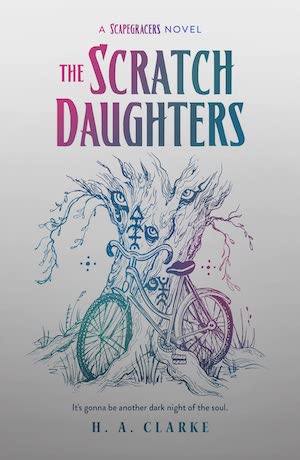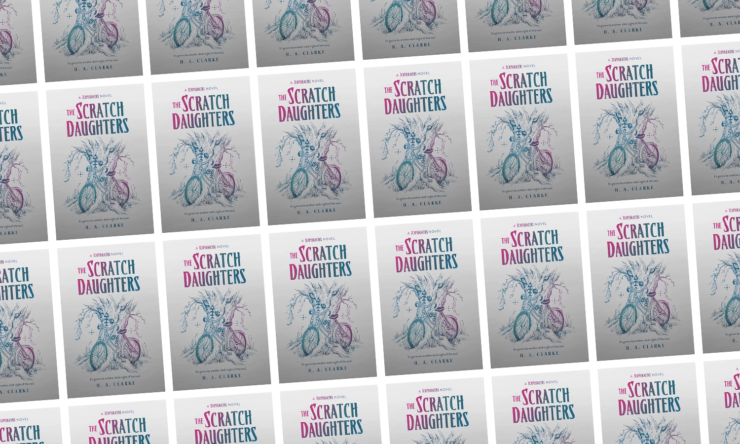Without a spectre, Sideways Pike is a husk of a person. Madeline, the cute girl who manipulated Sideways back in October to get revenge on the Chantry boys who stole her own specture, stole Sideways’ and disappeared. Sideways can feel Madeline using it to cast spells, unwieldy and uncontrollable spells rooted in stolen power, but that’s about all in the feelings department. Most witches who have their spectres ripped out die soon after. Madeline lasted as long as she did on spite alone, while Sideways is being propped up by Mr. Scratch the book devil currently renting out space in the powerless witch. His juice fuels the Scapegracers coven: razor-sharp Jing, stressed out Yates, angry Daisy, and brittle Sideways.
When one of the Chantry witchfinders is tossed out of their home, Sideways takes them in. Soon, a plan forms, a way to get revenge, to punish, and to solve their Madeline problem in one fell swoop. It would be easier if the rest of the Scapegracers were willing to go along with her impulsive and poorly thought out plan, but Sideways is going to get that spectre back or die trying.
If The Scapegracers was capital “Q” Queer, the The Scratch Daughters is a massive purple neon sign. Multiple characters come out, and two as something other than the gender foisted upon them at birth. I’m keeping this vague less because of spoilers and more because I think it’s important that the reader experience the questioning and unfolding of these characters’ identities alongside the characters. That being said, one of the characters who comes out as being under the gender expansive umbrella is one of the dreaded Chantry clan. Here, many authors would forgive that character’s countless sins and pull them into the coven with no hard feelings. H. A. Clarke doesn’t let them off that easy. They made choices, bad and impossible ones, but theirs nonetheless. They intentionally caused harm and potentially even got people killed. Being a closeted queer in an anti-queer family doesn’t absolve them of anything. Sideways holds them accountable, not by cutting them off but by giving them a chance. Sideways offers forgiveness dependent on that Chantry’s future actions. Reparations and restorative justice are the most important parts of an apology, queer or not.
Buy the Book


The Scratch Daughters
I also loved the way Clarke shows Sideways’ journey of figuring out they’re Not Cis. It’s not uncommon for a person who questions their sexual/romantic identity to also begin to question their gender identity (hello, it’s me, that was exactly how I ended up with the labels asexual, aromantic, and genderqueer). Little moments tend to have outsized impacts. Changing your hairstyle, a different top than you usually wear, trying on different pronouns in your head, being around other people also shucking off cisalloheteronormative rules, all can feel like taking a deep gulp of fresh air after holding your breath for too long. Some people have a sudden realization, others have always known who they are. And some of us have to stumble toward self-discovery, picking up pieces of ourselves society broke off of us and discarding others that never fit right. For some of us it’s the feeling of “Oh. Oh. Ohhhhhhhhh. OH. Well shit.” True to form, Sideways’ queer and gender identities are not simple or easily explained; they reject conformity and assimilation in every aspect of their life. This series has always been queer, but in this book queerness becomes a critical part of the plot. The ways these teens move through the branching paths of queerness directly impacts and is impacted by the main plot. Being queer isn’t a plot device—it is the plot.
Like The Scapegracers, the plot of The Scratch Daughters wanders and pauses and contemplates. All Sideways needs to do is track down Madeline. Simple right? But Clarke takes the story down a winding route through high school classes Sideways can barely remember and revenge side quests. The dallying may seem frivolous to readers who would rather jump straight to the action, but it’s all building blocks for the final confrontation. They give the reader a deep understanding of the Scapegracers’ desperation. Yes, these are four teenagers on the cusp of being thrown into the adult world to fend for themselves, but they’re also kids who don’t know what they’re doing half the time. They have college apps to fill out and parental figures to appease, not to mention gender and sexual identities to sort out. In true teenage fashion, even the smallest moments of friction can feel like a nuclear bomb exploding. Force a teen to live for weeks feeling like they’re surrounded by ticking time bombs and you’re going to end up with a lot of outbursts and reckless decisions.
Clarke sinks the reader into what actually feels like a good depiction of depression. I dealt with it a lot in my teens and twenties, and especially as a young person it’s so hard to care about your future when you can barely drag yourself through first period. The way you snap at your friends because sometimes an emotion as intense as anger is the only thing that can break through the haze of feeling nothing. The way you pretend everything is fine because you don’t want to keep disappointing the people who love you. The way you latch onto the one thing that might offer relief even if you know it’s the worst thing you could choose.
The Scratch Daughters is a sharp, scathing sophomore novel from H. A. Clarke. Middle books in trilogies often function more as table setting to the main event, but not this one. As much as I long for the next entry, if the series should end here at least it would go out on a high note.
The Scratch Daughters is published by Erewhon Books.
Alex Brown is a Hugo-nominated and Ignyte award-winning critic who writes about speculative fiction, librarianship, and Black history. Find them on twitter (@QueenOfRats), instagram (@bookjockeyalex), and their blog (bookjockeyalex.com).










